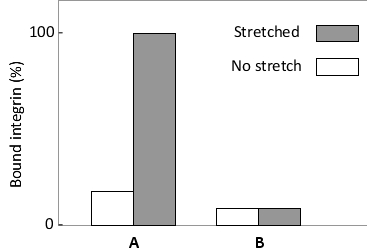Short Answer
EDTA is a metal-ion "chelator" that is commonly used to lower the concentration of free divalent cations in solution. In the lab, your friend has cultured a human cell line on elastic membranes that have been coated with fibronectin and attached to a device that can stretch the membrane. She has quantified the binding of talin to integrin under different conditions, and has presented the results in the following schematic graph, which shows the binding in the presence or absence of EDTA in the cell-culture medium. Which experiment (A or B) do you think was performed in the presence of EDTA? Write down A or B as your answer. 
Correct Answer:

Verified
Dependence of the binding of ...View Answer
Unlock this answer now
Get Access to more Verified Answers free of charge
Correct Answer:
Verified
View Answer
Unlock this answer now
Get Access to more Verified Answers free of charge
Q41: Cellulose is deposited onto the plant cell
Q42: Which of the following is NOT an
Q43: What is the most common additional polymer
Q44: Selectins …<br>A) mainly mediate cell-matrix attachments.<br>B) are
Q45: This large glycoprotein of the extracellular matrix
Q47: Which of the following is true regarding
Q48: Platelets that express a constitutively active Rap1
Q49: In the following schematic diagram, the estimated
Q50: Overproduction of cadherins such as E-cadherin …<br>A)
Q51: The focal adhesion kinase …<br>A) is a